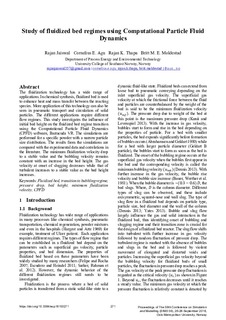| dc.contributor.author | Jaiswal, Rajan | |
| dc.contributor.author | Agu, Cornelius Emeka | |
| dc.contributor.author | Thapa, Rajan Kumar | |
| dc.contributor.author | Moldestad, Britt Margrethe Emilie | |
| dc.date.accessioned | 2019-02-13T08:32:40Z | |
| dc.date.available | 2019-02-13T08:32:40Z | |
| dc.date.created | 2018-11-29T17:39:05Z | |
| dc.date.issued | 2018 | |
| dc.identifier.citation | Linköping Electronic Conference Proceedings. 2018, (153), 271-276. | nb_NO |
| dc.identifier.issn | 1650-3686 | |
| dc.identifier.uri | http://hdl.handle.net/11250/2585130 | |
| dc.description.abstract | The fluidization technology has a wide range of applications. In chemical synthesis, fluidized bed is used to enhance heat and mass transfer between the reacting species. More application of this technology can also be seen in pneumatic transport and circulation of solid particles. The different applications require different flow regimes. This study investigates the influence of initial bed height on the fluidized bed regime transition using the Computational Particle Fluid Dynamics (CPFD) software, Barracuda VR. The simulations are performed for a specific powder with a narrow particle size distribution. The results from the simulations are compared with the experimental data and correlations in the literature. The minimum fluidization velocity drop to a stable value and the bubbling velocity remains constant with an increase in the bed height. The gas velocity at onset of slugging decreases while that of turbulent increases to a stable value as the bed height increases. | nb_NO |
| dc.description.abstract | Study of fluidized bed regimes using Computational Particle Fluid Dynamics | nb_NO |
| dc.language.iso | eng | nb_NO |
| dc.rights | Navngivelse-Ikkekommersiell 4.0 Internasjonal | * |
| dc.rights.uri | http://creativecommons.org/licenses/by-nc/4.0/deed.no | * |
| dc.title | Study of fluidized bed regimes using Computational Particle Fluid Dynamics | nb_NO |
| dc.type | Journal article | nb_NO |
| dc.type | Peer reviewed | nb_NO |
| dc.description.version | publishedVersion | nb_NO |
| dc.source.pagenumber | 271-276 | nb_NO |
| dc.source.journal | Linköping Electronic Conference Proceedings | nb_NO |
| dc.source.issue | 153 | nb_NO |
| dc.identifier.doi | 10.3384/ecp18153271 | |
| dc.identifier.cristin | 1637161 | |
| cristin.unitcode | 222,58,3,0 | |
| cristin.unitname | Institutt for prosess-, energi- og miljøteknologi | |
| cristin.ispublished | true | |
| cristin.fulltext | original | |
| cristin.fulltext | postprint | |
| cristin.qualitycode | 1 | |

